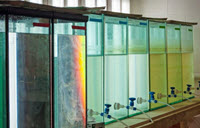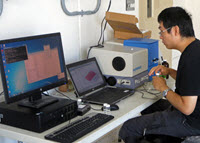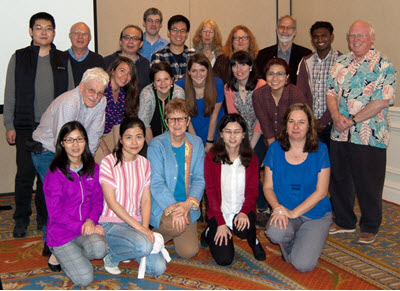
David uses mesocosms to simulate conditions in the natural ocean environment. (Photo credit: ADDOMEx)
Crude oil contains tens of thousands of hydrocarbons, including polycyclic aromatic hydrocarbons (PAHs) that create unique chemical fingerprints for different types of oil. Dawei “David” Shi uses geochemical analysis techniques in mesocosm studies to track these fingerprints, observe how they change over time, and investigate how dispersant affects PAH concentrations in the water column.
David is a Ph.D. student with Texas A&M University’s Department of Oceanography, a researcher with the Geochemical and Environmental Research Group (GERG), and a GoMRI Scholar with the Aggregation and Degradation of Dispersants and Oil by Microbial Exopolymers (ADDOMEx) consortium.
His Path
David’s parents encouraged his early interest in science as a child growing up in southern China where his father was a physical oceanography professor. He became interested in environmental science after visiting coastal cities as a middle school and high school student. These cities were located in the fastest-developing region of China, and the local environment suffered as a result.
David attended the Hong Kong University of Science and Technology where he completed a bachelor’s degree in chemistry and a master’s degree in environmental science. David’s application to Texas A&M University’s oceanography Ph.D. program caught the attention of Dr. Terry Wade, who thought that David’s scientific background would be perfect for his research investigating microbes’ role in oil sedimentation and degradation. Shortly afterwards, David began his Ph.D. work as a member of Wade’s lab.
His Work
While oil contains many hydrocarbons, only PAHs produce a strong fluorescent signature. PAHs typically represent a relatively fixed percentage of total petroleum hydrocarbons, allowing researchers to estimate the concentration of dissolved oil in a water sample based on its PAH concentrations. This measurement is called an estimated oil equivalent (EOE).

David takes fluorescence measurements to identify the presence of PAHs in his samples. (Provided by David Shi)
David investigates the role of microbes in oil sedimentation and degradation using mesocosm experiments to simulate the ocean environment. The ADDOMEx team prepares water-accommodated fractions (WAFs) and chemically enhanced WAFs (CEWAFs) by adding Macondo surrogate oil or surrogate oil plus Corexit 9500 (1:20 ratio, consistent with EPA recommendations) to seawater and filling twelve 120 L mesocosm tanks with these mixtures. The EOE in the mesocosms is 0.2-0.7 mg/L or ppm for WAF treatments and 39-81 mg/L or ppm for CEWAF treatments.
Then the team adds microbes collected with a plankton net from Galveston Bay and the Flower Garden Banks National Marine Sanctuary (an open ocean site in the Gulf of Mexico) to the mesocosm tanks. They collect water samples at the beginning of the experiment and every 24 hours for 72 – 96 hours thereafter and determines the EOE using total scanning fluorescence, an analytical technique that can selectively screen samples for PAH presence.
“It only takes approximately five minutes to process a sample using this technique, and it provides an approach to quickly determine the oil concentration in situ,” said David. “The main drawback of the fluorescence technique is that it provides few details about the composition of these PAHs, because their fluorescence signatures are very similar.”
David uses gas chromatography-mass spectrometry to fill in the missing information about the PAH compositions in the samples. His early results showed that low molecular weight (LMW) and high molecular weight (HMW) PAH concentrations reduced at about the same rate when dispersants were present. In trials without dispersants, LMW-PAHs vanished in about one day while HMW-PAHs persisted longer, with some compounds barely diminishing after four days. David said that this observation is important because HMW-PAH compounds are more carcinogenic than LMW-PAHs.
David believes that his preliminary results suggest that dispersant may alter the removal of PAH compounds from the water column, and he is working to characterize the nature of those alterations. He plans to conduct more mesocosm experiments that focus on the entry and removal of PAHs from sediments. “Hopefully, we will find out how much of these PAHs get into sediment and how much is biodegraded in situ,” he said. “Whether dispersants enhance oil biodegradation is still not clear, but it is an important issue and I hope my research can contribute to our understanding of it.”
His Learning
David’s research experiences have shown him the importance of cross-field training to an environmental science career. Because he analyzes data primarily from a chemistry perspective, he felt “enlightened” when he heard other researchers discuss the results in a biological context. He has enjoyed the poster sessions during Gulf of Mexico Oil Spill and Ecosystem Science conferences because presenters provided insights into his work. “People from different scientific backgrounds walked by and discussed my poster with me,” he explained. “Not only did I enjoy making connections to fellow scientists, sometimes the discussion itself was really inspiring and encouraged me to think outside the box.”

David (back row, far left) and the ADDOMEx research team in June 2016. (Provided by David Shi)
His Future
David plans to pursue a post-doc position in China followed by an academic or industry career that would allow him to use his education and expertise to improve China’s environmental conditions. He advises students considering a scientific career to engage in a wide range of sciences, “One should have a very broad understanding of all natural science fields, rather than simply focusing on one’s own discipline.”
The GoMRI community embraces bright and dedicated students like David Shi and their important contributions. The GoMRI Scholars Program recognizes graduate students whose work focuses on GoMRI-funded projects and builds community for the next generation of ocean science professionals. Visit the ADDOMEx website to learn more about their work.
************
The Gulf of Mexico Research Initiative (GoMRI) is a 10-year independent research program established to study the effect, and the potential associated impact, of hydrocarbon releases on the environment and public health, as well as to develop improved spill mitigation, oil detection, characterization and remediation technologies. An independent and academic 20-member Research Board makes the funding and research direction decisions to ensure the intellectual quality, effectiveness and academic independence of the GoMRI research. All research data, findings and publications will be made publicly available. The program was established through a $500 million financial commitment from BP. For more information, visit http://gulfresearchinitiative.org/.
© Copyright 2010- 2017 Gulf of Mexico Research Initiative (GoMRI) – All Rights Reserved. Redistribution is encouraged with acknowledgement to the Gulf of Mexico Research Initiative (GoMRI). Please credit images and/or videos as done in each article. Questions? Contact web-content editor Nilde “Maggie” Dannreuther, Northern Gulf Institute, Mississippi State University (maggied@ngi.msstate.edu).
